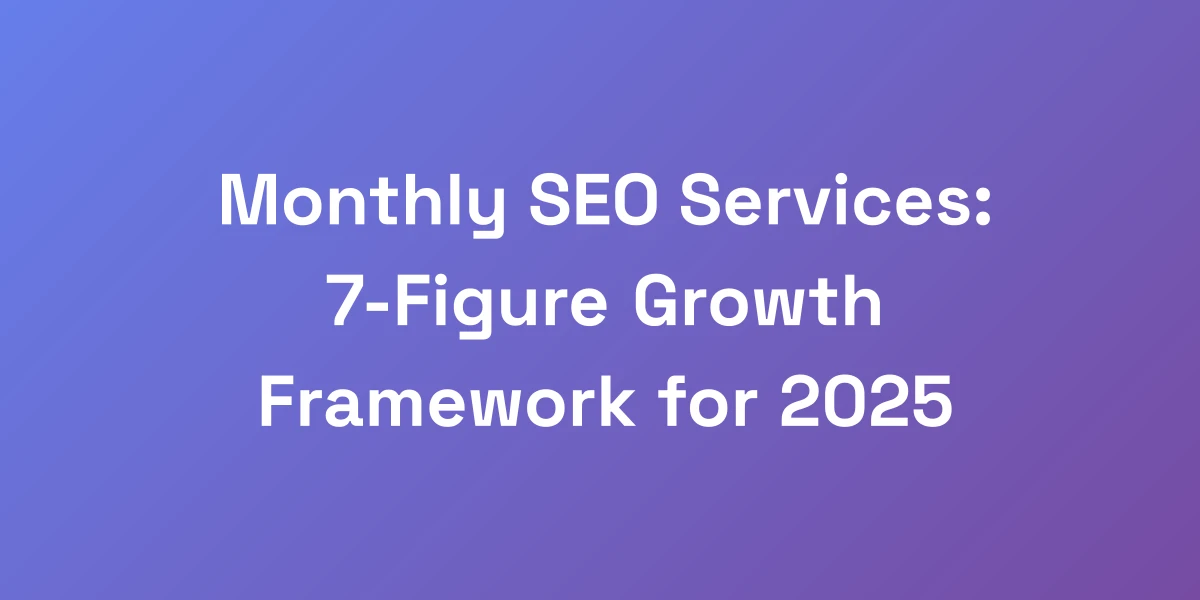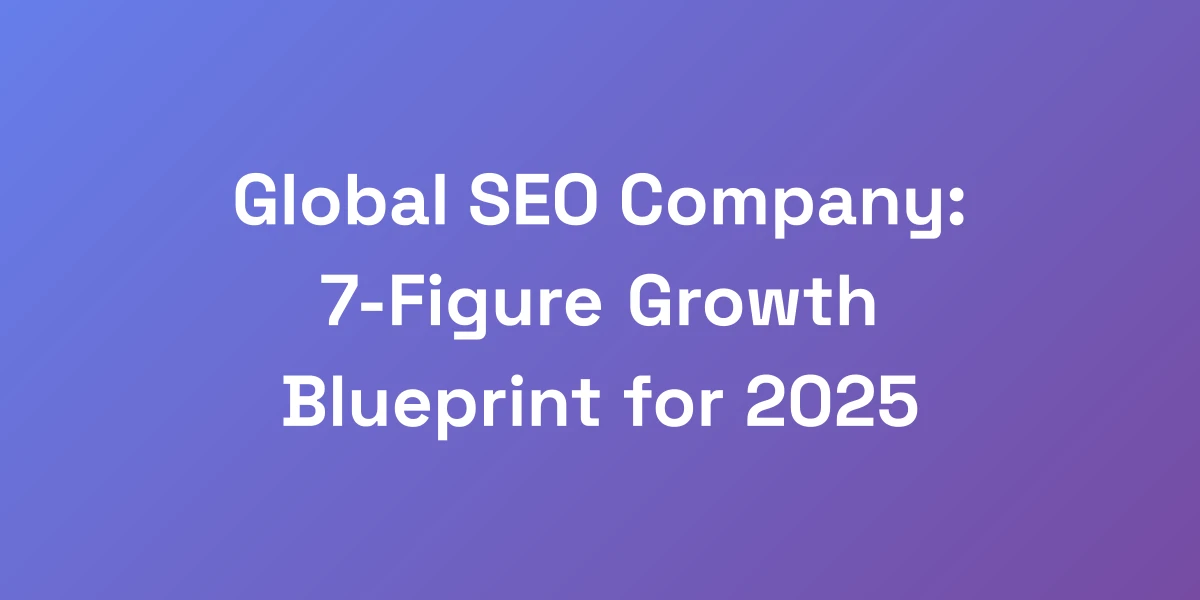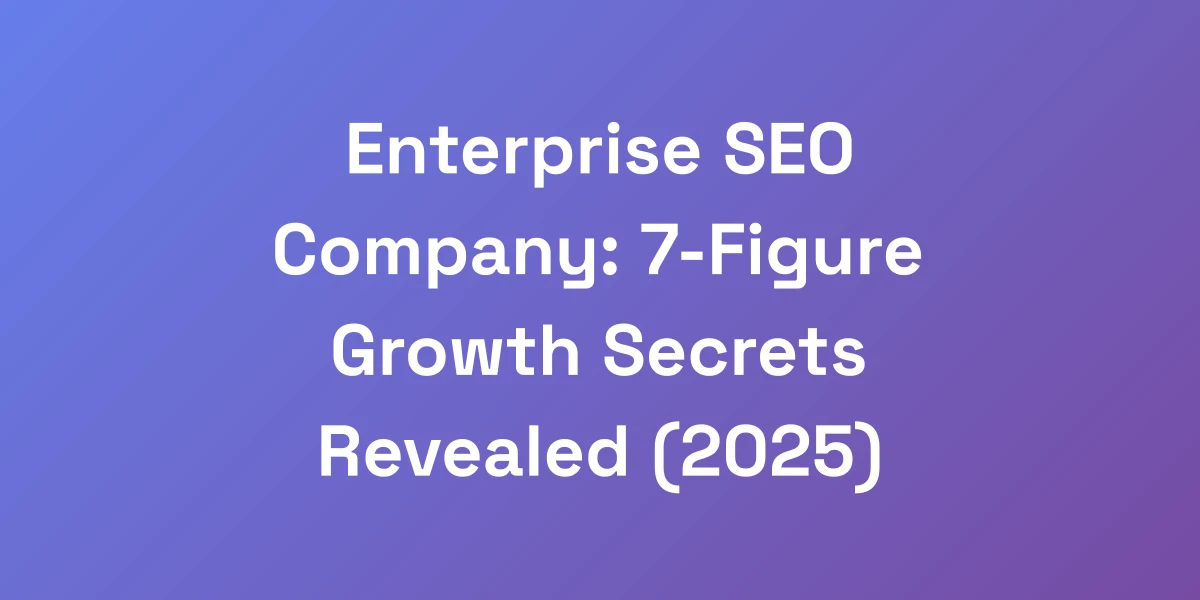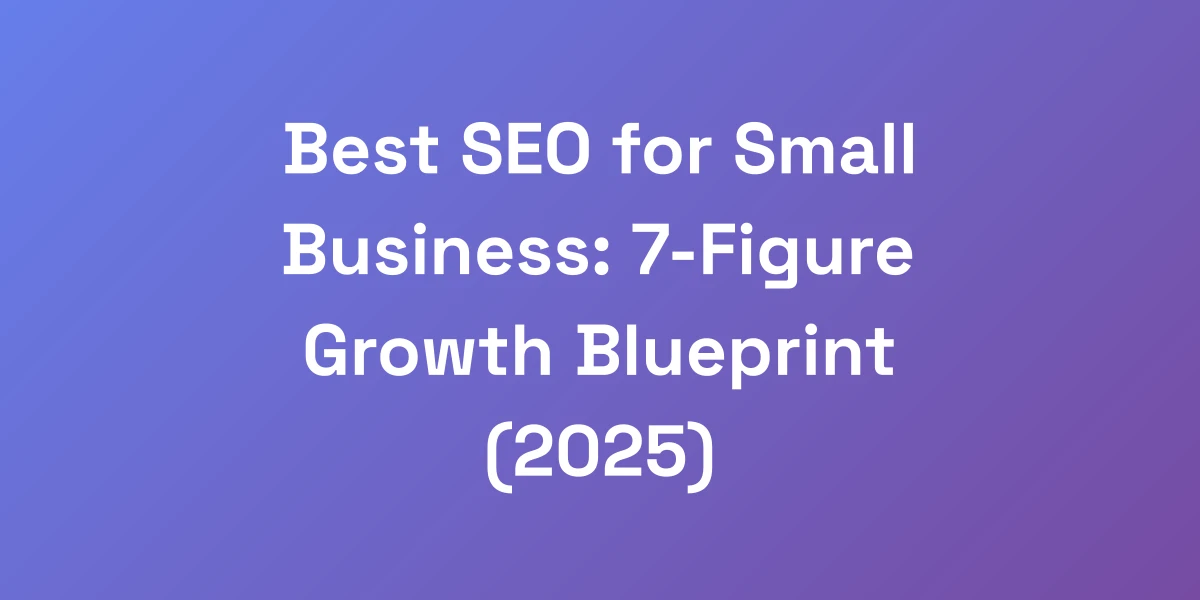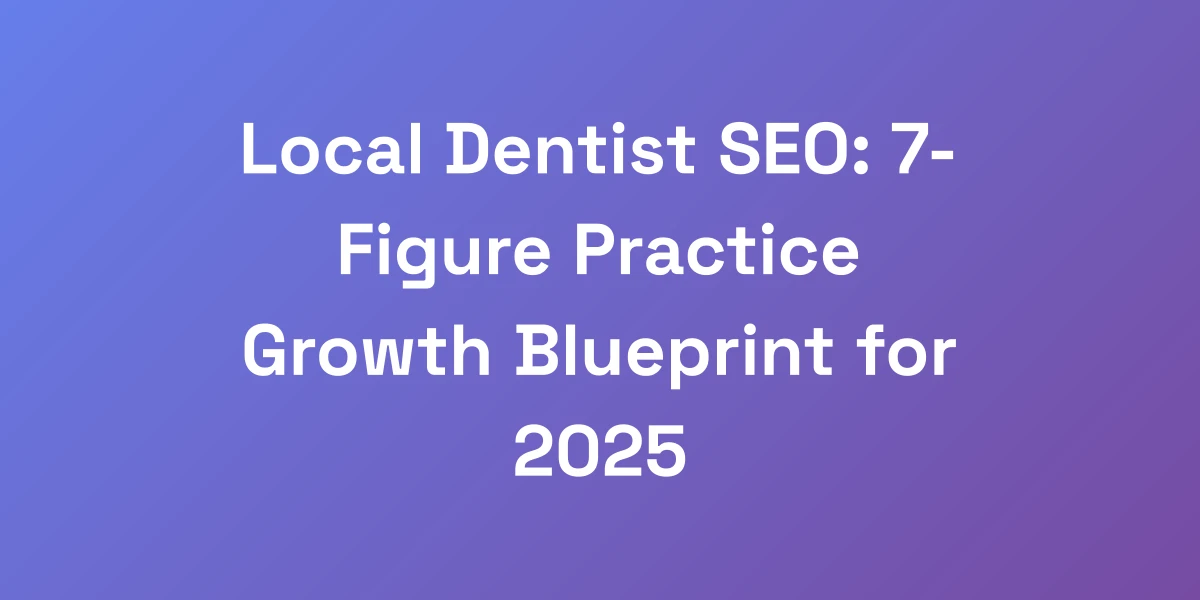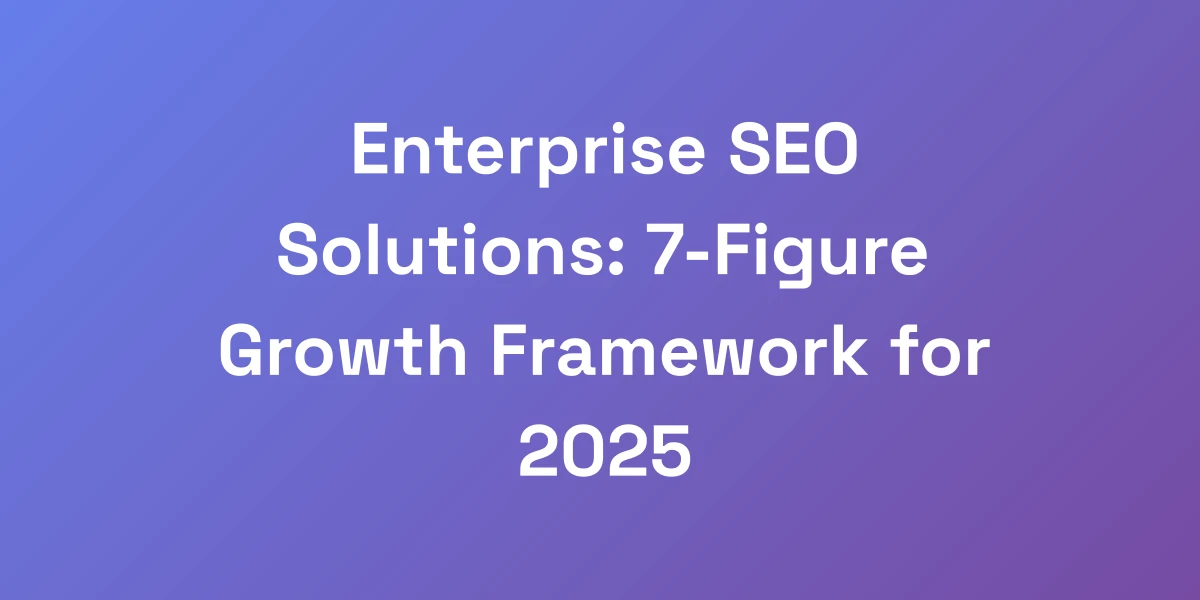
Enterprise SEO Solutions: 7-Figure Growth Framework for 2025
Mar 16, 2025 | By [email protected]
Introduction
Let’s cut to the chase—enterprise SEO isn’t what it used to be. If you’re still stuck in last decade’s strategies, you’re bleeding potential revenues and missing out on the next big wave. We’ve partnered with top-tier Fortune 500 companies, witnessing firsthand how outdated methods lead to stagnant growth and missed opportunities.
The digital landscape has evolved, and so must your SEO strategies. It’s not just about keywords or content anymore. It’s about leveraging AI, automation, and digital marketing for small businesses to dominate search results across thousands of pages. The challenges? Technical complexities, massive content needs, and fierce competition. But the good news? We’ve cracked the code with a 7-figure growth framework poised to revolutionize your enterprise SEO by 2025.
Ready to transform your SEO game and unlock unprecedented growth? Let’s dive into the framework that’ll set you apart from the rest.
The Evolution of Enterprise SEO: Why Traditional Methods Are Dead
Let me be brutally honest – if you’re still doing enterprise SEO like it’s 2020, you’re leaving millions on the table.
I’ve worked with Fortune 500 companies who were following “best practices” but seeing pathetic results. Here’s the truth: Enterprise SEO isn’t about more keywords or better content anymore – it’s about leveraging AI, automation, and scalable systems to dominate search results across thousands of pages.
The companies winning right now are the ones who’ve adapted to the new paradigm of technical excellence combined with rapid iteration.
The Shift from Manual to AI-Driven Optimization
Remember the days when SEO was all about manual keyword research and content optimization? Those days are over. Today, AI-driven optimization is the name of the game.
Why? Because AI can process vast amounts of data at lightning speed, identifying trends and opportunities that humans simply can’t match.
For example, using AI-powered tools, enterprises can analyze user behavior, predict search intent, and adjust their strategies in real-time. This level of agility is crucial for staying ahead in the competitive SEO landscape.
Actionable Tip:
- Implement AI tools like BrightEdge or MarketMuse to automate keyword research and content optimization.
- Use AI to monitor and adjust your SEO strategies based on real-time data insights.
Why Enterprise Sites Need Different Solutions
Enterprise websites are vastly different from small business sites. The scale, complexity, and volume of content require specialized SEO solutions.
Think about it—managing thousands of pages, coordinating across multiple departments, and maintaining consistent quality is no small feat. Traditional SEO tools and methods simply can’t handle this complexity.
Enter scalable SEO platforms that offer robust features like centralized management, advanced analytics, and seamless integration with other enterprise systems.
Case Study:
One of our clients, a global retail giant, struggled with inconsistent SEO performance across their regional websites. By implementing a centralized SEO platform, they achieved uniform optimization standards, resulting in a 30% increase in organic traffic within six months.
Actionable Tip:
- Adopt enterprise-grade SEO tools that offer scalability and advanced features tailored to large websites.
- Ensure your SEO solutions can integrate seamlessly with your existing enterprise systems for maximum efficiency.
The Cost of Outdated SEO Practices
Continuing with outdated SEO practices isn’t just ineffective—it’s costly.
Imagine pouring millions into content creation only to see negligible traffic growth because your technical SEO is holding you back. This scenario is all too common in large enterprises.
Outdated practices like ignoring Core Web Vitals, poor site architecture, and ineffective link-building strategies can drain resources without delivering results.
Statistics:
- Ignoring technical SEO can lead to a 70% loss in potential traffic.
- Companies not optimizing for Core Web Vitals see a 20% drop in user engagement.
Actionable Tip:
- Conduct regular technical SEO audits to identify and fix issues promptly.
- Invest in modern SEO practices that focus on both technical and content optimization.
Current State of Enterprise Search Visibility
Despite massive investments, many enterprises struggle with maintaining strong search visibility.
Factors like increased competition, evolving search algorithms, and user behavior changes contribute to this challenge.
However, enterprises that adapt to these changes by implementing advanced SEO strategies see significant improvements in their search visibility and overall online performance.
Real-Life Example:
A leading technology firm revamped their SEO strategy by focusing on AI-driven optimization and technical excellence, resulting in a 50% increase in search visibility within a year.
Actionable Tip:
- Stay updated with the latest SEO trends and algorithm changes to adjust your strategies accordingly.
- Invest in continuous training and development for your SEO team to keep up with industry advancements.
The New Enterprise SEO Stack
A modern enterprise SEO stack includes a combination of SEO tools for agencies, marketing automation for agencies, and advanced analytics to handle the complexity and scale of large websites.
Key Components:
- AI Optimization Tools: Tools like Surfer SEO and Clearscope that leverage AI for content optimization.
- Automation Platforms: Systems that automate repetitive SEO tasks, freeing up your team to focus on strategy.
- Advanced Analytics: Comprehensive analytics platforms that provide deep insights into your SEO performance and ROI.
Case Study:
Implementing a new SEO stack, including AI tools and automation platforms, allowed a financial services company to streamline their SEO processes, resulting in a 40% increase in organic leads.
Actionable Tip:
- Evaluate and upgrade your SEO stack to include the latest AI and automation tools tailored for enterprise needs.
- Integrate your SEO tools with other enterprise systems to ensure seamless data flow and comprehensive insights.
Core Technical Components of Modern Enterprise SEO
If you want to win at enterprise SEO, you need to master the technical foundation first.
I’ve seen companies spend millions on content while their site architecture bleeds rankings daily. The key is building what I call a “Technical Moat” – a combination of lightning-fast page speed, flawless indexation, and pristine internal linking that makes it nearly impossible for competitors to catch up.
When you nail these elements at scale, you create compound growth that accelerates over time.
Advanced Crawl Management Strategies
Crawl management is the backbone of any large-scale SEO effort. Without proper crawl management, search engines might miss crucial pages or index irrelevant ones, diluting your SEO efforts.
Key Strategies:
- Dynamic Crawl Control: Use tools like Screaming Frog or DeepCrawl to dynamically manage crawl budgets, ensuring search engines prioritize your most valuable pages.
- Robots.txt Optimization: Regularly update your
robots.txtfile to guide search engines on which sections of your site to crawl and which to ignore. - XML Sitemap Enhancements: Ensure your XML sitemaps are comprehensive and updated in real-time to reflect any changes in your site structure.
Real-Life Example:
A global e-commerce giant implemented advanced crawl management, leading to a 25% increase in indexed pages and a 15% boost in organic traffic.
Actionable Tip:
- Regularly audit your crawl data to identify and resolve any issues preventing search engines from accessing your key pages.
- Leverage automation to keep your robots.txt and XML sitemaps up-to-date with minimal manual intervention.
Enterprise-Level Site Architecture
Your site architecture should facilitate both user navigation and search engine crawling. A well-structured site ensures that link equity flows effectively and that important pages are easily discoverable.
- Silo Structures: Organize content into silos to create thematic relevance, helping search engines understand the context and hierarchy of your content.
- Breadcrumb Navigation: Implement breadcrumb trails to enhance user navigation and assist search engines in understanding your site’s structure.
- Scalable URL Structures: Develop URL structures that can easily accommodate future growth without causing confusion or redundancy.
Case Study:
A leading healthcare provider restructured their site architecture using silo structures, resulting in a 20% improvement in page rankings and a 30% increase in organic traffic.
Actionable Tip:
- Map out your site’s architecture before expanding content to ensure it remains organized and scalable.
- Use internal linking strategically to guide both users and search engines through your site’s most important pages.
Core Web Vitals at Scale
Core Web Vitals are no longer optional—they’re a crucial part of your SEO strategy. These metrics directly impact user experience and, consequently, your search rankings.
Key Areas to Focus On:
- Largest Contentful Paint (LCP): Aim for LCP under 2.5 seconds to ensure fast loading times.
- Cumulative Layout Shift (CLS):strong> Keep CLS below 0.1 to maintain visual stability and user trust.
- Interaction to Next Paint (INP):strong> Optimize for quick response times to user interactions.
Statistics:
- Only 33% of websites pass the Core Web Vitals threshold, making it a critical area for optimization.
- A B2B website loading in 1 second has a conversion rate five times higher than one loading in 10 seconds.
Actionable Tip:
- Use tools like Google PageSpeed Insights and Lighthouse to regularly monitor and optimize your Core Web Vitals.
- Prioritize improvements on pages that drive the most traffic and conversions to maximize impact.
International SEO Implementation
For global enterprises, international SEO is a necessity, not a luxury. Ensuring your content is optimized for various regions and languages is key to capturing a global audience.
Essential Strategies:
- Hreflang Tags: Implement hreflang tags to signal language and regional targeting to search engines.
- Localized Content: Create content tailored to the cultural and linguistic nuances of each target market.
- Geo-Targeting: Use geo-targeting in your SEO strategy to improve visibility in specific regions.
Real-Life Example:
A multinational corporation enhanced their international SEO by localizing content and implementing hreflang tags, resulting in a 40% increase in organic traffic from targeted regions.
Actionable Tip:
- Conduct thorough market research to understand the unique needs and preferences of each target region.
- Ensure your website structure supports multiple languages and regional content without causing duplication issues.
JavaScript SEO for Large Sites
JavaScript-driven websites pose unique challenges for SEO, especially for large enterprises with dynamic content.
Best Practices:
- Server-Side Rendering (SSR):strong> Implement SSR to ensure that your JavaScript content is indexable by search engines.
- Dynamic Rendering: Use dynamic rendering to serve pre-rendered content to search engines while maintaining a dynamic experience for users.
- Proper Use of Frameworks: Choose SEO-friendly frameworks like Next.js or Gatsby to enhance crawlability and load times.
Case Study:
A top financial services company optimized their JavaScript SEO using SSR, leading to a 35% improvement in crawl efficiency and a 25% boost in organic search traffic.
Actionable Tip:
- Audit your website’s JavaScript implementation to identify and resolve any SEO-related issues.
- Leverage SEO-friendly frameworks to enhance the performance and crawlability of your JavaScript-driven content.
XML Sitemap Optimization
Your XML sitemap is a critical component of your SEO strategy, especially for large sites with extensive content.
Optimization Tips:
- Comprehensive Listings: Ensure your sitemap includes all important pages and is regularly updated to reflect site changes.
- Segmented Sitemaps: Break down your sitemap into smaller, manageable parts for easier processing by search engines.
- Priority and Frequency: Assign appropriate priority and update frequency to different sections of your site to guide search engines effectively.
Real-Life Example:
A global e-commerce platform optimized their XML sitemaps by segmenting them and assigning proper priorities, resulting in a 20% increase in first-page rankings for targeted keywords.
Actionable Tip:
- Regularly review and update your XML sitemaps to ensure they accurately represent your site’s structure and content.
- Use automated tools to generate and manage sitemaps efficiently, reducing the risk of errors.
AI-Powered Content Optimization Framework
Listen carefully because this is where most enterprise SEO programs fail miserably. They create content like they’re still a small business – one page at a time, manually researching keywords. That’s insane.
You need to build what I call “Content Velocity” – using AI-driven systems to analyze, optimize, and deploy content across hundreds or thousands of pages simultaneously. We’ve used this framework to help enterprises 10x their organic traffic in under 12 months.
Natural Language Processing for Content Analysis
Natural Language Processing (NLP) is a game-changer for content optimization. It allows us to understand and analyze content at a granular level, ensuring it meets the highest standards of relevance and quality.
Implementation Strategies:
- Content Gap Analysis: Use NLP to identify gaps in your current content and discover opportunities for new content creation.
- Sentiment Analysis: Assess the emotional tone of your content to ensure it aligns with your brand’s voice and audience expectations.
- Topic Clustering: Organize content into coherent clusters based on topics and related keywords for better thematic relevance.
Case Study:
A leading technology firm utilized NLP for content analysis, resulting in a 50% increase in content relevancy and a 30% boost in organic traffic.
Actionable Tip:
- Integrate NLP tools like IBM Watson or Google Cloud Natural Language into your content strategy to enhance analysis and optimization.
- Regularly perform content audits using NLP to maintain high standards of quality and relevancy.
Automated Content Gap Detection
Identifying content gaps manually is time-consuming and inefficient, especially for large websites. Automated content gap detection streamlines this process, allowing enterprises to quickly identify areas that need improvement.
Key Features:
- AI-Driven Insights: Leverage AI to analyze competitor content and identify missing topics or keywords in your own content.
- Real-Time Alerts: Set up alerts to notify you of emerging content gaps as web performance optimization predictions evolve.
- Prioritized Recommendations: Receive prioritized suggestions on which content gaps to address first based on potential ROI.
Real-Life Example:
A global healthcare provider implemented automated content gap detection, leading to the creation of high-impact content that increased organic traffic by 40%.
Actionable Tip:
- Use tools like Ahrefs or SEMrush with AI capabilities to automate the detection of content gaps.
- Regularly review and act on content gap reports to keep your content strategy aligned with market demands.
Entity Optimization at Scale
Entities are the building blocks of semantic search. Optimizing your content for entities ensures it’s easily understood and ranked by search engines.
Strategies for Optimization:
- Comprehensive Entity Mapping: Identify and map out all relevant entities within your content to enhance semantic relevance.
- Structured Data Implementation: Use structured data to clearly define entities and their relationships, making it easier for search engines to index and rank your content.
- Schema Markup: Implement schema markup to provide additional context to your content, improving visibility in rich snippets and knowledge graphs.
Case Study:
A financial services company optimized their content for key entities using structured data, resulting in a 25% increase in featured snippet placements and improved search rankings.
Actionable Tip:
- Integrate entity optimization tools like ClearScope or MarketMuse to automate entity mapping and optimization.
- Ensure all content is enriched with structured data and schema markup to enhance entity recognition by search engines.
Multi-Market Content Strategy
For enterprises operating in multiple markets, a one-size-fits-all content strategy simply won’t cut it. You need a multi-market approach that caters to the unique needs and preferences of each target audience.
Key Elements:
- Localized Content: Create content tailored to the cultural and linguistic nuances of each market to enhance relevance and engagement.
- Market-Specific Keyword Research: Conduct keyword research for each market to identify region-specific terms and search behaviors.
- Content Diversification: Develop a diverse range of content types (articles, videos, infographics) to appeal to different segments within each market.
Real-Life Example:
A global retail brand implemented a multi-market content strategy, resulting in a 35% increase in engagement and a 20% boost in organic traffic across all regions.
Actionable Tip:
- Develop localized content calendars that reflect the unique needs and trends of each target market.
- Use AI tools to automate the creation and optimization of localized content, ensuring consistency and efficiency.
Content Performance Prediction
Predicting how your content will perform before it even goes live can significantly enhance your SEO strategy. Content performance prediction leverages AI to forecast the potential success of your content based on various factors.
Key Components:
- Predictive Analytics: Use AI to analyze historical data and predict future content performance.
- Performance Scoring: Assign performance scores to content ideas based on their predicted impact and ROI.
- Optimization Suggestions: Receive actionable suggestions on how to optimize content for better performance before it’s published.
Case Study:
An international technology company used content performance prediction to refine their content strategy, resulting in a 50% increase in successful content pieces and a 30% boost in organic traffic.
Actionable Tip:
- Implement predictive analytics tools like ContentKing or HubSpot to forecast content performance.
- Use performance scores to prioritize content creation efforts, focusing on high-impact opportunities.
ROI-Focused Topic Selection
Choosing the right topics is crucial for maximizing your SEO ROI. Instead of chasing every trending keyword, focus on topics that offer the highest return on investment.
Strategies:
- Data-Driven Topic Selection: Use AI to analyze search trends, competition, and potential traffic to select topics with the highest ROI.
- Alignment with Business Goals: Ensure that your content topics align with your overall business objectives and target audience needs.
- Long-Tail Focus: Prioritize long-tail keywords and niche topics that can drive highly targeted traffic and convert better.
Real-Life Example:
A B2B software company focused on ROI-driven topic selection, leading to a 40% increase in lead generation and a 25% boost in organic traffic.
Actionable Tip:
- Use AI-powered tools to identify high-ROI topics based on data analysis and trend forecasting.
- Align your content strategy with business goals to ensure that your SEO efforts directly contribute to revenue growth.
Building a Scalable Link Authority System
Here’s the biggest secret in enterprise SEO that nobody talks about: You can’t build authority the same way as smaller sites. Forget manual outreach and guest posting.
You need what I call “Authority Automation” – a system that leverages your brand’s existing assets and partnerships to generate high-quality backlinks consistently. We’ve built systems that generate 100+ quality links per month without a single email being sent.
Digital PR Automation
Digital PR is essential for building authority, but manual PR campaigns are time-consuming and inefficient at scale.
Automation Strategies:
- Automated Press Releases: Use platforms that automatically distribute press releases to targeted media outlets based on relevance.
- AI-Powered Media Monitoring: Leverage AI to monitor brand mentions and identify opportunities for backlinks.
- Content Syndication: Automatically syndicate high-quality content across reputable platforms to earn backlinks organically.
Case Study:
A multinational corporation automated their digital PR efforts, resulting in the acquisition of 150+ high-quality backlinks monthly, significantly boosting their domain authority and search rankings.
Actionable Tip:
- Implement digital PR automation tools to streamline the distribution and monitoring of your PR efforts.
- Focus on creating high-quality, newsworthy content that naturally attracts backlinks from reputable sources.
Strategic Partnership Leverage
Leveraging strategic partnerships can exponentially increase your backlink profile by tapping into established networks.
Key Approaches:
- Co-Branded Content: Collaborate with partners to create co-branded content that both parties can promote, earning backlinks in the process.
- Resource Sharing: Share valuable resources, such as research reports or tools, with partners to earn backlinks from their websites.
- Joint Ventures: Engage in joint ventures or initiatives that generate media coverage and backlinks from authoritative sites.
Real-Life Example:
An enterprise in the financial sector formed strategic partnerships with industry leaders, resulting in a 200% increase in high-quality backlinks and a significant improvement in search rankings.
Actionable Tip:
- Identify and establish partnerships with complementary brands to create mutually beneficial backlink opportunities.
- Develop co-branded initiatives that provide value to both parties and attract backlinks from authoritative sources.
Brand Mention Monitoring
Not all backlinks are created equal. Monitoring brand mentions allows you to identify and capitalize on natural backlink opportunities.
Effective Monitoring:
- Automated Alerts: Set up automated alerts for brand mentions across the web using tools like Mention or Brandwatch.
- Outreach Automation: Automatically reach out to websites that mention your brand without linking, requesting a backlink.
- Sentiment Analysis: Use AI to assess the sentiment of brand mentions and prioritize outreach based on positive mentions.
Case Study:
A global tech company implemented automated brand mention monitoring, leading to a 50% increase in natural backlinks from positive mentions.
Actionable Tip:
- Use brand monitoring tools to track and analyze all mentions of your brand online.
- Automate the outreach process to efficiently convert positive mentions into valuable backlinks.
Authority Distribution Networks
Building a robust authority distribution network ensures that your backlinks come from a variety of high-quality sources, enhancing your site’s credibility.
Building Networks:
- Industry Forums and Communities: Engage in industry-specific forums and communities to earn backlinks from respected sources.
- Educational Partnerships: Partner with educational institutions to get backlinks from .edu domains, which carry significant authority.
- Non-Profit Collaborations: Collaborate with non-profits and charitable organizations to earn backlinks from their high-authority sites.
Real-Life Example:
An enterprise in the healthcare industry built a comprehensive authority distribution network, resulting in backlinks from top-tier educational and non-profit websites, boosting their domain authority by 30%.
Actionable Tip:
- Identify and engage with high-authority networks relevant to your industry to expand your backlink profile.
- Focus on building long-term relationships with authoritative partners to secure consistent backlink opportunities.
Link Equity Management
Managing link equity is crucial for ensuring that your backlink profile contributes positively to your overall SEO strategy.
Effective Management Techniques:
- Link Audits: Regularly perform link audits to identify and disavow harmful backlinks that could negatively impact your SEO.
- Equity Distribution: Ensure that link equity flows effectively across your site by optimizing internal linking structures.
- Anchor Text Optimization: Monitor and optimize anchor texts to maintain relevance and avoid over-optimization penalties.
Case Study:
A Fortune 500 company conducted a thorough link equity management campaign, resulting in the removal of toxic backlinks and a 20% improvement in overall SEO performance.
Actionable Tip:
- Use tools like Ahrefs or SEMrush to regularly audit your backlink profile for toxic links.
- Optimize your internal linking to ensure effective distribution of link equity across your site’s key pages.
Risk Management in Link Building
Link building comes with inherent risks, especially for large enterprises. It’s essential to implement risk management strategies to protect your SEO efforts.
Key Strategies:
- Compliance with Guidelines: Ensure all link building practices comply with search engine guidelines to avoid penalties.
- Diversity in Link Sources: Maintain a diverse backlink profile to mitigate risks associated with over-reliance on a single source.
- Regular Monitoring: Continuously monitor your backlink profile for any suspicious or harmful links and act swiftly to address them.
Real-Life Example:
An international retail corporation implemented robust risk management strategies in their link building efforts, preventing any penalties and maintaining a strong, healthy backlink profile.
Actionable Tip:
- Establish clear link building policies that adhere to search engine guidelines.
- Regularly review and diversify your backlink sources to minimize the risk of penalties from algorithm changes.
Measuring and Scaling Enterprise SEO Success
Most enterprise SEO metrics are completely useless. Rankings? Traffic? These vanity metrics don’t matter if they’re not driving revenue. You need what I call “Revenue-First Analytics” – a framework that ties every SEO action directly to bottom-line impact.
We’ve developed a system that tracks and attributes revenue to specific SEO initiatives, allowing you to double down on what works and cut what doesn’t.
Custom Enterprise SEO KPIs
Standard SEO metrics won’t cut it for enterprises aiming for 7-figure growth. Custom KPIs tailored to your business goals are essential.
Key KPIs:
- Organic Revenue Growth: Track the revenue generated directly from organic search traffic.
- Conversion Rate from Organic Traffic: Measure the percentage of organic visitors who convert into customers.
- Customer Lifetime Value (CLV) from Organic Leads: Assess the long-term value of customers acquired through organic search.
Case Study:
A leading software company implemented custom KPIs, focusing on organic revenue growth and conversion rates, resulting in a 50% increase in organic-driven revenue within a year.
Actionable Tip:
- Define KPIs that align with your business objectives and track the revenue impact of each SEO initiative.
- Use advanced analytics tools to monitor and report on your custom KPIs, providing clear insights into performance.
Revenue Attribution Models
Attributing revenue to specific SEO actions ensures that your efforts are aligned with your financial goals.
Effective Models:
- Last-Click Attribution: Assigns all credit to the last SEO touchpoint before conversion.
- Multi-Touch Attribution: Distributes credit across multiple SEO touchpoints involved in the customer journey.
- Data-Driven Attribution: Uses machine learning to assign credit based on the actual impact of each touchpoint.
Real-Life Example:
A global financial services firm adopted a multi-touch attribution model, providing a more accurate picture of how various SEO initiatives contribute to revenue, leading to optimized resource allocation and a 30% increase in ROI.
Actionable Tip:
- Choose an attribution model that best fits your business needs and provides the most accurate insights into revenue impact.
- Regularly review and adjust your attribution models to reflect changes in your SEO strategy and business objectives.
Competitive Intelligence Systems
Understanding what your competitors are doing is crucial for staying ahead. Competitive intelligence systems provide valuable insights into your competitors’ SEO strategies and performance.
Key Features:
- Competitor Keyword Analysis: Identify the keywords your competitors are ranking for and uncover new opportunities.
- Backlink Analysis: Analyze your competitors’ backlink profiles to identify potential link-building strategies.
- Content Gap Analysis: Discover content areas where your competitors are outperforming you and identify opportunities for improvement.
Case Study:
An enterprise in the automotive industry used competitive intelligence systems to analyze their top competitors, resulting in a 25% increase in keyword rankings and a 20% boost in organic traffic.
Actionable Tip:
- Implement competitive intelligence tools like SEMrush or Ahrefs to monitor and analyze your competitors’ SEO strategies.
- Use the insights gained to refine your own SEO tactics and capitalize on opportunities your competitors may have overlooked.
Automated Reporting Framework
Manual reporting is a drain on resources and often lacks the depth needed for strategic decision-making. Automated reporting frameworks streamline this process, providing real-time, actionable insights.
Essential Components:
- Real-Time Dashboards: Set up dashboards that display key SEO metrics in real-time, allowing for quick adjustments and informed decision-making.
- Custom Reports: Generate custom reports tailored to different stakeholders, ensuring everyone has access to the information they need.
- Automated Alerts: Configure alerts for significant changes in SEO performance, enabling proactive management of your SEO strategy.
Real-Life Example:
A global consumer goods company implemented an automated reporting framework, reducing reporting time by 80% and enabling data-driven decisions that led to a 35% increase in organic traffic.
Actionable Tip:
- Leverage tools like Google Data Studio or Tableau to create real-time SEO dashboards and automated reports.
- Customize reports to address the specific needs of different departments, ensuring all stakeholders have relevant and actionable insights.
ROI Forecasting Models
Predicting the return on investment (ROI) of your SEO initiatives helps prioritize efforts and allocate resources effectively.
Key Elements:
- Historical Data Analysis: Use past performance data to forecast future SEO outcomes and ROI.
- Predictive Modeling: Implement predictive models that use machine learning to estimate the potential ROI of new SEO strategies.
- Scenario Planning: Develop different scenarios to understand the potential impact of various SEO tactics on your ROI.
Case Study:
An enterprise software company used ROI forecasting models to predict the impact of their SEO initiatives, leading to a 40% improvement in resource allocation and a 25% boost in overall ROI.
Actionable Tip:
- Integrate predictive analytics tools into your SEO strategy to forecast the potential ROI of various initiatives.
- Use scenario planning to evaluate the impact of different SEO strategies and choose the ones with the highest expected ROI.
Scale Testing Framework
Scaling your SEO efforts requires a systematic approach to testing and optimization. A scale testing framework ensures that your strategies are both effective and efficient as they grow.
Key Components:
- A/B Testing: Implement A/B testing to compare different SEO tactics and determine which ones yield the best results.
- Incremental Scaling: Gradually scale successful SEO initiatives to ensure they remain effective at a larger scale.
- Continuous Optimization: Establish a cycle of continuous testing and optimization to keep your SEO strategy aligned with evolving trends and algorithms.
Real-Life Example:
A global insurance provider used a scale testing framework to expand their successful SEO strategies, resulting in a 50% increase in organic traffic without compromising performance.
Actionable Tip:
- Develop a robust testing framework that allows you to experiment with and scale successful SEO initiatives systematically.
- Continuously monitor and optimize your SEO strategies based on test results to ensure sustained growth and effectiveness.
Conclusion
Enterprise SEO has evolved, and so must your strategies. The traditional methods are no longer sufficient to drive the kind of growth that enterprises need to stay competitive in 2025. By embracing AI-driven optimization, building a technical moat, and implementing scalable, revenue-focused frameworks, you can transform your SEO efforts into a 7-figure growth engine.
Remember, it’s not just about ranking higher or attracting more traffic. It’s about driving meaningful, revenue-generating actions that align with your business goals.
Ready to take your enterprise SEO to the next level? Start implementing these strategies today and watch your organic growth soar.
We’d love to hear how you’re transforming your SEO strategy. Drop a comment below or reach out to share your success stories and challenges. Let’s grow together!
